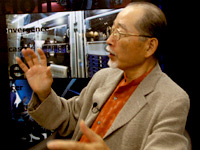Inter BEE Special Interview Audio Section Taro Kimura & Mick Sawaguchi [Part1]
2007.9.21 UP

Kimura: "What is 5.1 surround?" Sawaguchi: "I don't think there is anything that would not benefit from being in surround sound." The discussion kicks off with the appeal of this technology, which is not as widely understood as people think.
Kimura
Actually, for the production staff who make the programs, the trickiest thing is sound. Audio is at the root of most problems.
Sawaguchi
Oh dear. [laughs]
Kimura
Sometimes you find you're getting the video feed from a location, but no audio. Actually sound is really important in TV broadcasting, and yet until now I think we haven't paid it nearly enough attention. I have to confess we're guilty. Will you forgive us? [laughs] Now, with everything going digital, audio is also undergoing a radical transformation. How do those of you on the front line see this?
Sawaguchi
At last the time we've been waiting for has arrived: we can achieve with audio what we've been long wanting to. Since about 1985 we have had this conviction that, after stereo, the next important phase in audio evolution will be surround sound. In 2003 terrestrial digital TV broadcasting started, so the production side is pretty much ready and waiting for surround, I would say.
Kimura
When stereo came on the scene, I thought that, since we have two ears, two channels is all you need, right? Then along came surround sound, with its additional rear channels, making 5 in all. I apologize for asking such a basic question, but does surround really make that much of a difference? Or, to put it another way, are the human ears really that sensitive?
Sawaguchi
We have two ears, but actually we also have this incredible faculty for hearing tens of thousands of channels from 360 degrees around us. Stereo meant we were listening for information on just 2 of all those possible channels. With 5.1channels we have trebled that, so the listener can get a very clear idea of the "air information" from the source. It thus sounds more natural.
Kimura
If that's the case, before long 5.1 will be replaced by 10.1or 20?
Sawaguchi
That's more than possible.
Kimura
Really! So it's possible that the number of audio tracks will increase, in the same way that the scanning lines for the TV picture continue to increase indefinitely?
Sawaguchi
Yes. The more channels you have, the better the reproduction. Certainly it would cause problems if we filled our living rooms with speakers, but researchers have been investigating 7.1, 10.2, 22.2, and so on.
Kimura
Another beginner's question, I'm afraid, but what exactly is the significance of the period in "5.1"?
Sawaguchi
In movies especially, to lend some impact to the sound of an explosion or of a punch, they spice it up by vibrating the air at low frequencies, less than 100 Hertz. That represents no more than about 10% of the total range we hear, so that's why it's always "point one". And that's also why we have a total of 6 channels. But for music or documentary programs, the 5 main channels are quite enough for reproducing the low range.
Kimura
If live sports programs were broadcast in 5.1, it would really sound three-dimensional, I think. What sort of other uses would be effective?
Sawaguchi
I don't think there is anything that would not benefit from being in surround sound. Take sports - golf, for example. At first, there were quite a few doubts raised about whether there was any sense in doing golf in surround sound. But the feeling you get of the club head colliding with the ball is something else. The sound generated at the very instant it makes contact, I mean. If you are actually standing there on the green, the "swack" reverberates in your ears. Stereo can't capture that air information, because the sound is compressed. But with surround sound, the "swack" of the impact is free and natural, like it's resounding in a pine forest. The sound is real. [Continues to Part 2]







